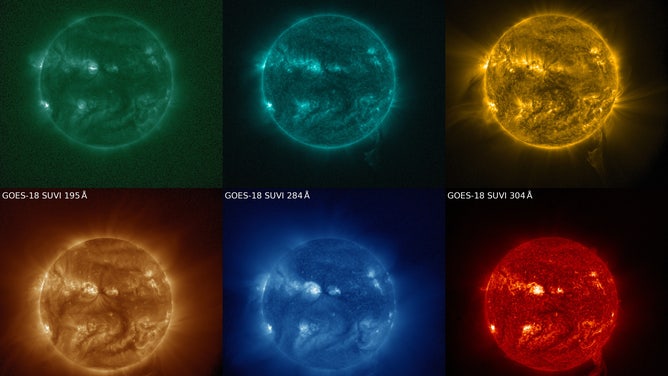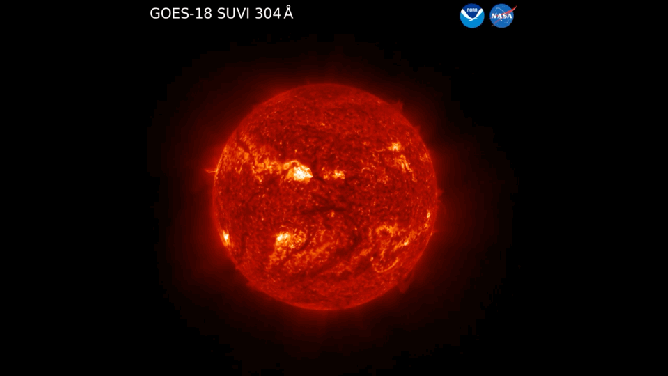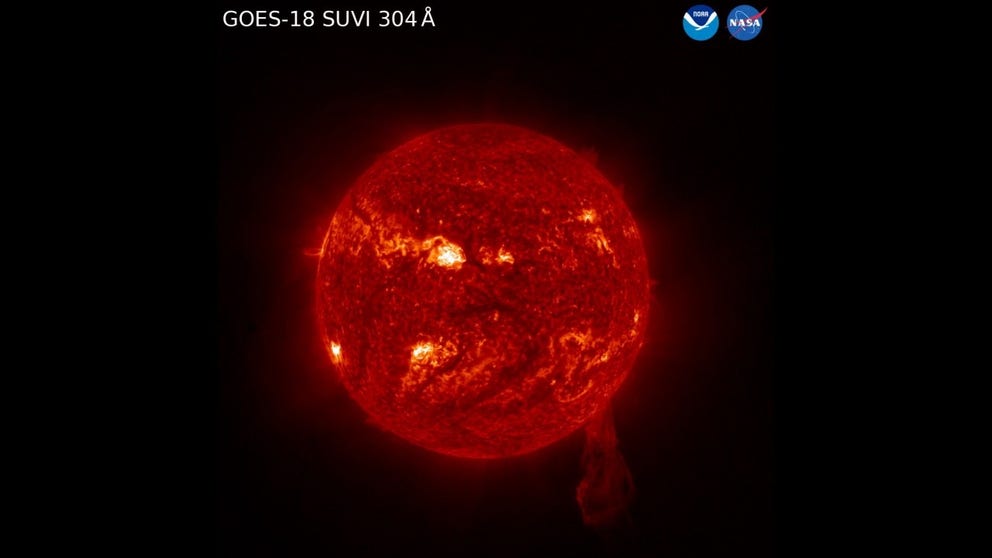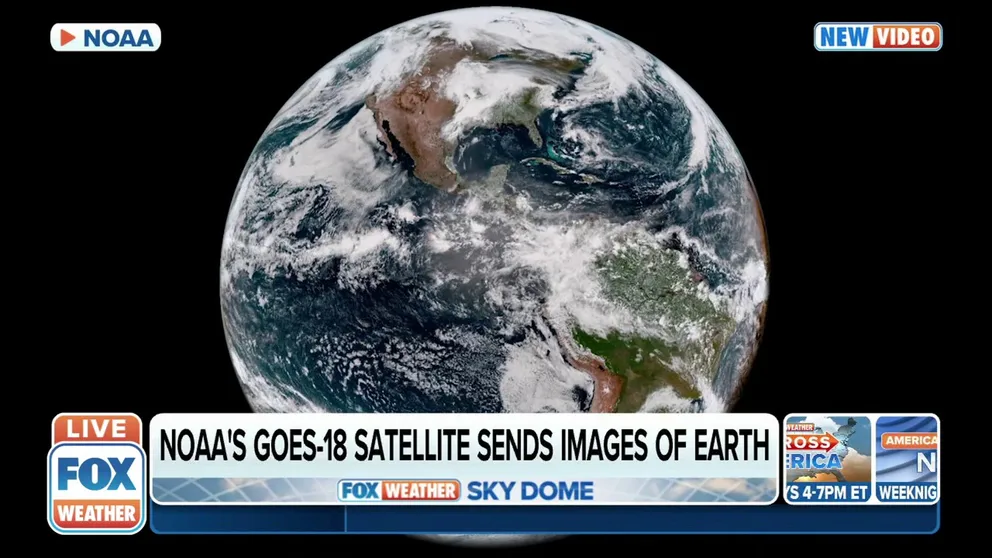Beautiful swirling eruption from the sun showcases NOAA satellite's ability to forecast space weather
After launching in March, GOES-18 is testing its Solar Ultraviolet Imager instrument and providing images of swirling plasma ejecting from the sun
GOES-18 instrument records explosive sun activity
NOAA's GOES-18 satellite's Solar Ultraviolet Imager, or SUVI, recorded a coronal mass ejection (CME) from the sun in six wavelengths. The CME sent a tangle of plasma hurtling out into the atmosphere while some of it is sucked back up into the sun.
NOAA is releasing stunning images of the sun taken by its newest weather satellite showing swirling plasma ejecting from the solar atmosphere into space and getting sucked back into the sun.
GOES-18 launched from Florida in March and is the third NOAA's GOES-R geostationary satellite series. It's in the final phases of commissioning its powerful weather-observing instruments, including the Solar Ultraviolet Imager (SUVI), which helps forecast space weather.
A version of SUVI has flown on all newer GOES satellites and can send back images to Earth within minutes to forecasters with NOAA's Space Weather Prediction Center.
46 YEARS OF GOES: HOW A HISTORY OF ACHIEVEMENTS HAS CHANGED WEATHER FORECASTING
Dr. Laurel Rachmeler is the head of the Solar & Terrestrial Physics section of NOAA's National Centers for Environmental Information. She and her team work on calibration and validation of space weather instruments, like SUVI. While forecasters work to share weather data with the public, the NCEI makes sure the quality of the data is up to par.
As testing and calibration wrap up on the newest satellite, there will soon be three eyes in the sky observing the sun continuously.
SUVI's eyes see in many colors

The GOES-18 SUVI observes the sun in six X-ray and extreme-ultraviolet (EUV) channels, as seen in the image above. The clearest depiction of the CME captured on July 10, 2022 is in the 304A channel (lower right in red).
(NOAA)
Because the sun is so hot, images of the sun are taken in ultraviolet wavelengths.
Each SUVI channel is a different wavelength of ultraviolet light, which samples plasma to varying temperatures in the outer atmosphere of the sun, known as the corona. NOAA recently released the image above showing the differences between all six channels.
The orange-red image (bottom right) is the 304 Angstroms wavelength measuring cooler plasma at 50,000 degrees Kelvin in the chromosphere, the layer below the corona.
"That's what we solar physicists call cool," Rachmeler said.
SMILE! FIRST IMAGES ARRIVE FROM NEW GOES-18 WEATHER SATELLITE

NOAA's GOES-18 satellite's Solar Ultraviolet Imager, or SUVI, recorded a coronal mass ejection (CME) from the sun in six wavelengths. The CME sent a tangle of plasma hurtling out into the atmosphere while some of it is sucked back up into the sun.
This image is from 304A.
Rachmeler explains that the video shows a prominence or filaments erupting in the lower right corner of the sun.
"As it lifts up, you see this kind of twisting or twisting motion. And that happens as this massive plasma and magnetic field is slowly moving away from the sun," Rachmeler said.
As the video continues, the material continues to spiral as it gets pulled back down to the sun. This is what's known as a partial eruption.
"If the magnetic field is still connected to the sun as it was erupting, some of that filament material can actually travel back down the magnetic field and back down to the surface of the sun," Rachmeler said.
The golden-hued 171 Angstrom wavelength (top right) is a favorite for Rachmeler because she has studied solar magnetic fields.
At about 1 million degrees Kelvin, it's some of the coolest plasma in the corona. Structures emanate from the edge of the disk, tracing the lines of magnetic fields.
"You see these kind of structures emanating from the edge of the disk and going out these kind of thin lines, and those are tracing the lines of magnetic fields. Those are tracing the direction that the magnetic field is in," Rachmeler said. "Because of that, 171 is a really excellent way for my brain to process in a very quick look at this. All right. What is the magnetic field doing today?"
Space weather forecasting
SUVI provides daily data for space weather forecasters and observations over time that help solar scientists learn about the evolution of solar activity.
"SUVI is also really important because it shows us what is the base state of the sun? Where are the active regions? Where are there really long prominences? Where are there things called corona holes that can also cause minor geomagnetic storms?" Rachmeler said.
FEAST YOUR EYES: 'CANNIBAL' SOLAR FLARE TRIGGERS SPECTACULAR NORTHERN LIGHTS SHOW
For most people, there is not usually a reason to be concerned about CMEs or solar flares. Most of the effects of a geomagnetic storm are on technology infrastructures, including aviation, satellites, electric power, GPS and radio communications.
"If you're an astronaut, you have to pay attention, and if you are an airline crew, that does a whole lot of polar routes," Rachmeler said. "In terms of actual like radiation effects for the general public, there are very few."
NOAA's Space Weather Prediction Center forecasts, including Geomagnetic Storm Watches, are targeted toward private and federal organizations to know what's coming and give them time to take steps to protect their systems.
From Earth's view, eruptions closer to the center of the sun are more likely to cause geoeffective CMEs.
SUVI can help forecasters see if a CME has a large solar flare and where it originated.
"If the origin is somewhere closer to the center of the disk, we can pay closer attention to it and assume that it's going to come towards us and do more targeted modeling of it," Rachmeler said.
A recent SUVI observation by the GOES-16 satellite recorded a CME on July 21, prompting the Space Weather Prediction Center to issue a G2 (moderate) geomagnetic storm warning, which can sometimes bring beautiful northern lights to the northern U.S.
20 years of continuous sun observations
NOAA's GOES-18 satellite sends back its first images of Earth
On Wednesday, May 11, NOAA shared the first images of Earth from its GOES-18 satellite.
Different variations of SUVI have flown on the newest GOES satellites starting with GOES-16 in 2017. GOES-U will launch in 2024 and observe the sun until at least 2040.
BEFORE NOAA SATELLITES CAN IMPROVE WEATHER FORECASTS, HERE'S WHERE THEY ARE BUILT
"That means we get to watch the sun for over two full solar cycles with the same instrument. So we get a really long continuity there," Rachmeler said.
A solar cycle is 11 years, and at all times, there is now a SUVI watching the sun, which guarantees forecasters and researchers learn as much as they can about the sun's behavior.
Rachmeler said that while the first extreme-ultraviolet sun observations were taken in 1946, solar science still has a long way to go.
"There's a lot for us still to learn, and we've come a long way since then, but there's no shortage of questions that are still there to be discovered."

